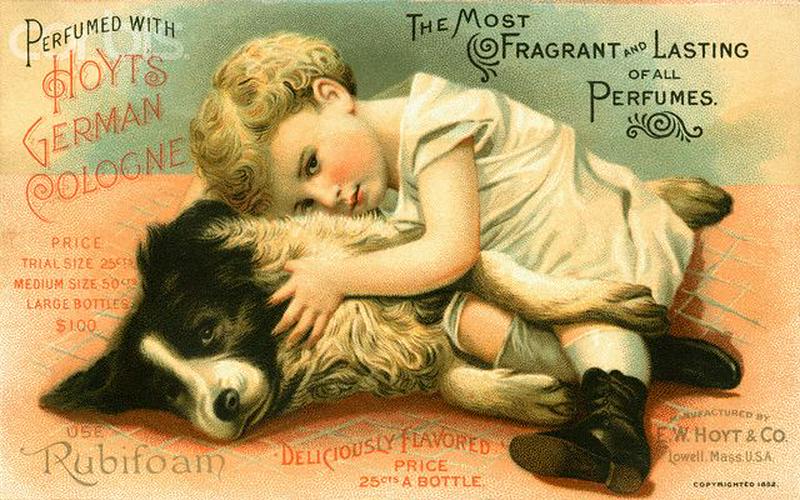The Weird History Of Babies In Advertising
By | March 8, 2020

It's no secret that babies are popular. As a species, we have about 258 of them every minute, so if we weren't designed to find their squishy little faces adorable enough to withstand their relentless screaming, the situation would get intolerable in approximately three seconds. Given this natural inclination, it's not surprising that once advertising hit its heyday in the 1800s, babies started cropping up faster than a Wiggles concert at Legoland.

When Did Babies In Advertising Start?
Advertising has largely emerged hand-in-hand with humanity's literacy rate. In ancient Rome, China, Greece, and Arabia, advertisements were written or printed, but less literate societies used music or town criers to literally get the word out. As an in-between step, some shops used simple symbols like boots for cobblers or horseshoes for blacksmiths. With the advent of Gutenberg's printing press in 1440 and improvements made to it throughout the next dozen or so decades, written forms of advertisement really started picking up steam in the 1600s. After the first weekly publications launched in Venice and spread to Europe, it didn't take long for publishers to consider defraying costs by offering to let people buy ad space in the paper. The first newspaper ad in England, echoing an ad from ancient Rome, requested the return of a stolen horse. (In Rome, it was a stolen slave. Progress!)

Most of these early advertisements, whether they were spoken, symbolized, or written, dealt with household goods or medicines. They placed most of their weight in simple (although often greatly exaggerated) product descriptions, and any accompanying images were typically of the good being sold. That all changed when Englishman Thomas J. Barratt, commonly called the father of modern advertising, got into the game in 1865. His ads for the Pears soap company used slogans and images to make his product stand out. Specifically, images of babies.

Babies Imply Family Values
Using people's values to sell things to them was nothing new. Tobacco companies marketed "rugged" cigarettes to working-class men and a "delicate fragrance" to the elite. When Barratt began working for the Pears soap company after marrying the boss man's daughter, he used images of adorably messy toddlers in upper middle-class homes to convey a sense of safety, comfort, and high quality.

Babies Catch Our Attention
Something about a baby's facial structure—the big eyes, little nose, small chin, and chubby cheeks—is like catnip to us. It's called kindchenschema, a term coined by Konrad Lorenz in 1949 to describe why, evolutionarily, we are so gosh-darned interested in babies and baby-faced people. He won the Nobel Prize, but he was also a Nazi, so take that with a grain of salt.
He was onto something, though. Morten Kringelbach, a senior research fellow at the University of Oxford, conducted a study of 12 adults responding to videos of 27 infants with a neuroimaging technique called magnetoencephalography, which provides resolution of whole brain activity up to the millisecond in millimeter-level detail. He and his colleagues discovered that our happy response to babies begins within milliseconds in the medial orbitofrontal cortex, which is literally at the front of our minds, just above the eyeballs. "The brain activity in the orbitofrontal cortex could help us pay more attention, protect, and cuddle the infant," Kringelbach told Discovery News.

Baby Faces Make Us Feel Good
Whether on actual babies or not, baby faces release dopamine into the brain, commonly known as the "feel good" chemical. They also tend to inspire feelings of nurturing and caregiving. Lorenz theorized that part of the reason for that is because such features usually indicate a healthy, well-fed baby who's a good evolutionary investment. Chubby cheeks? Fantastic. Symmetrical and big-headed? Even better. It's why Baby Yoda took over the entire internet and Planters killed off Mr. Peanut for a deeply hated merchandising campaign cringingly entitled Baby Nut. They want us to associate the good investment of a healthy baby with the good investment of their product.

We're Slaves To Our Subconsciousness
Advertisers typically sort ads into two categories: ads that sell with facts, and ads that sell with feelings. In general, people prefer their utilitarian products to be factual and their hedonistic ones to be emotional, but older adults tend to prefer their feelings to lead the way in all things. Where ads are meant to play with our subconscious and intuition, Freud steps in. Sex does sell, but so does the product of sex.

It's not just the straight shot of dopamine that makes babies in advertising so effective. According to James Breeze, babies act as amplifiers; we're more likely to look where a baby is looking. Mirror neurons (that thing in the brain that makes us happy when we see someone else who's happy) also play a factor. This can be just as effective in the other direction: If a baby in a commercial is crying or frightened, we're much more likely to want to step in to fix the situation.

Babies Convey Need
When we're not feeling all soft and gooey about seeing a baby in an advertisement, we're often feeling fear or concern about what could happen (or is happening) to the baby. A Michelin ad becomes much more compelling when you plop a baby in there with the declaration "So much is riding on your tires." You may or may not be particularly worried about the safety of your tires, but wouldn't you take it much more seriously if your mediocre tires could be responsible for hurting a baby? Babies can also make a strong case for self-preservation, as in the A-Tap Earplugs ad above that shows an obviously exhausted baby whose screams are blocked by a giant earplug. Evolution has wired us to take care of both babies and ourselves, which makes them one heck of a visual marketing tool.

